FR237 Focal Reducer and eFinder Assembly
(Replaces the FR5C focal reducer)
June 23, 2000
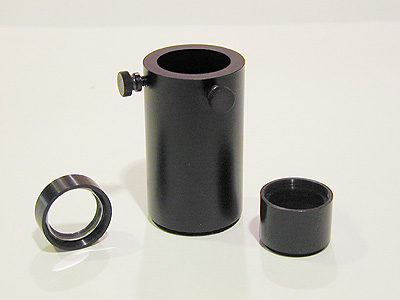 |
FR237 Focal Reducer and eFinder Assembly |
The FR237 Focal Reducer and eFinder Assembly is actually two accessories. It is a variable focal reducer that will reduce an F/10 optical system to F/3.75 and it is an ultra compact wide field telescope that may be used for imaging, an electronic finder or autoguiding. The image at right shows the three parts that make up the entire assembly: an achromatic focal reducer lens (left), a 3 inch "eFinder" extension tube (middle) and a short 1.25" extension tube (right).
FOCAL REDUCER
The Focal Reducer lens is mounted in a 1.25" cell that will screw into the 1.25" nosepiece of the STV, ST-237, ST-5C or ST-4. When used with the short 1.25" extension tube the amount of focal reduction is increased. The chart below gives an example of the effective focal ratios one will achieve with different telescopes.
The ST-5C, for instance, uses a relatively small CCD, 3.2 by 2.4 mm, that may be inconvenient when attempting to image extended objects with longer focal length telescopes. For example, the field of view when used with an 8" F/10 telescope is only 4.1 by 5.5 arc-minutes. The FR237 focal reducer is designed to reduce the focal ratio of an F/10 telescope to F/5.95 or F/3.75. At F/3.75 the CCD, with this typical telescope, would image an area of 11 by 14.7 arc-minutes. The result is a sharper appearing image with crisper star images, an increase in field of view of 7X, and an increase in sensitivity to extended and nebular objects by 7X. Since the pixel size is still smaller than a stellar image under typical seeing conditions, no resolution is lost. The image improvement is dramatic with diffuse nebulae and galactic objects! An ST-5C with a focal reducer is nearly equivalent to an ST-6 used without one, for considerably less cost.
Although the STV and ST-237 use a detector that is twice the size of the detector used in the ST-5C, the same increase in field of view and sensitivity apply. The 237 detector has a field of view of approximately 6 by 8 arcminutes (48 arcminutes square) when used at the prime focus of an 8" F10 telescope. With the FR237 operating at F3.75 the field of view of the TC237 detector becomes 16 by 21 arcminutes (336 arcminutes square) and extended objects appear 7 times as bright. This can be particularly important with the STV video camera where one may wish to keep exposure times as short as possible.
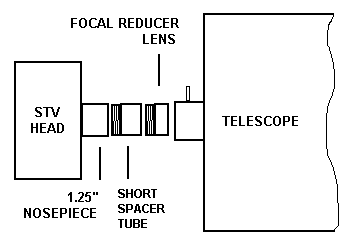 |
|||
| Focal Ratio of Parent System | F/14 | F/10 | F/6.3 |
| Resulting focal ratio w/o spacer tube | F/8 | F/5.95 | F/3.75 |
| Resulting focal ratio w/ spacer tube | F/5.25 | F/3.75 | n/a |
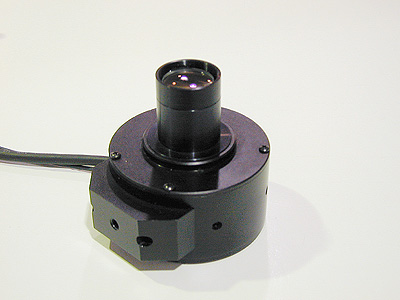 |
FR237 Focal Reduce in the nose piece of an STV |
The picture at left shows the FR237 as it is used as a focal reducer only. The focal reducer lens is screwed into the nosepiece of an STV but it works equally well with the ST-4, ST-5, ST-5C, PixCel 255, ST-237 and PixCel 237. In this configuration the camera head may be inserted into any telescope that uses a 1.25" eyepiece holder. The focal reducer also includes a short extension tube that may be used to vary the amount of focal reduction (see the chart above). Using the focal reducer not only shortens exposure times, but it also increases the field of view which is often desired when using relatively small CCDs to image through larger telescopes. The effect of adding a focal reducer to a typical 8" f/10 SCT is seen in the sample images below which were taken with an ST-5C and a C8 telescope.
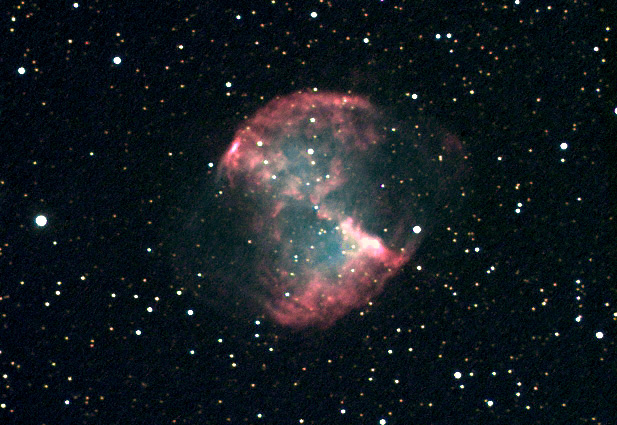 |
This image of M27 was taken with an ST-237
using an FR237 focal reducer through a C8 |
eFINDER ASSEMBLY
The eFinder is recommended accessory for the STV and it works equally well on the ST-237 and ST-5C cameras. Only the focal reducer lens may be used on the ST-4, however, because the eFinder extension tube attached to the camera head by t-threads and the 1.25" nosepiece on the ST-4 does not unscrew. To use the eFinder assembly on the STV, ST-237 or ST-5C one simply unscrews the 1.25" nosepiece and replaces it with the eFinder assembly.
The eFinder consists of the focal reducer lens described above plus the 3 inch long "eFinder" extension tube which together form a 100mm focal length f/4 telescope. When mounted piggy back on a larger telescope, the combination forms an electronic finderscope and guide scope with a field of view of 2.7 by 2.0 degrees (1.4 by 2.0 degrees with the ST-5C). This image scale makes comparison of the displayed image with a star chart very easy. This combination is also sensitive enough to show any star in Uranometria with a 3 second exposure.
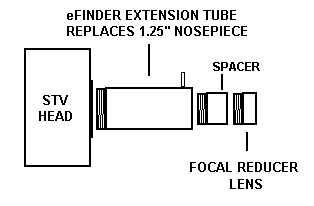 |
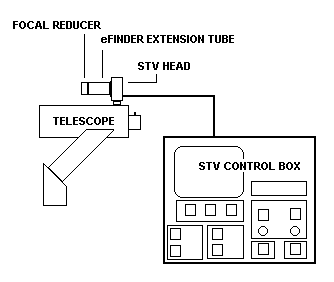 |
The eFinder Assembly: Mount piggy back on a telescope as an electronic finder scope or guide scope |
|
As a guide scope the eFinder will autoguide to better than 1 arc second accuracy (depending on the quality of your mount). With its wide field of view there will virtually always be a guide star in the field of view without having to search for one. This means that the eFinder assembly can be securely fastened without being concerned about having to adjust its pointing to find guide stars. By locking the eFinder down tight on the main scope you minimize the problems associated with differential deflection of a guide scope. The CCD head and eFinder assembly is only about 5" long overall and weighs little more than a pound. This makes it exceptionally easy to guide telescopes up to about approximately 100" in focal length. Of course, no separate guide scope can detect a shift in the position of an SCT's primary mirror. For this reason, or when doing longer exposures particularly with long focal length scopes, the STV equipped with the FR237 may be used in an off-axis guider for best results.
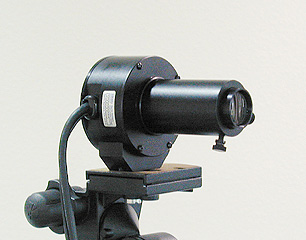 |
eFinder Assembly attached to STV head on tripod |
Assembling the e-Finder Components and Attaching to the Telescope
Attach the short extension tube (0.8 inch) to the focal reducer by screwing them together. They screw together with the joint being away from the lens. Next, slide the focal reducer assembly into the 3 inch finderscope extension tube. Use the thumb screws to position the assembly about midway into the extension tube. Screw the resulting finderscope assembly into the front of the STV, ST-237 or ST-5C camera head. Using a camera mount (not supplied) for piggybacking a camera onto your telescope, attach the eFinder assembly in such a way that when the telescope moves in RA the star image moves parallel to the long axis of the CCD.
The following sample images
taken with ST-5C through 8" SCT demonstrate
the dramatic improvement made by using a focal reduce on an appropriate object
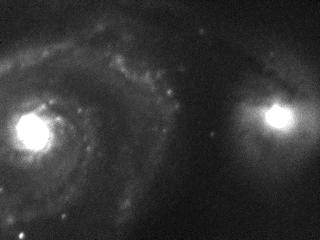 |
M51 at f/10 |
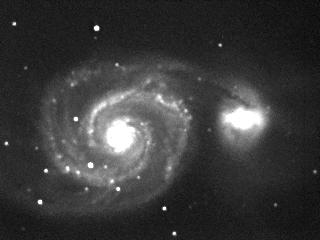 |
M51 at f/5
|
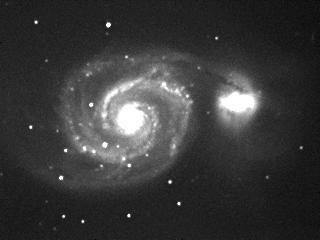 |
M51 at f/4 5 minute image taken with ST-5C and 8" SCT at f/4 with focal reducer with spacer ring. Image field of view is approximately 9.3 x 12.4 arc minutes. Nebulosity is slightly brighter than f/5 image and the galaxy is nicely framed in the field. Star images are still sharp near the edge of the field. |
Go to Price List
Go back to SBIG Products page